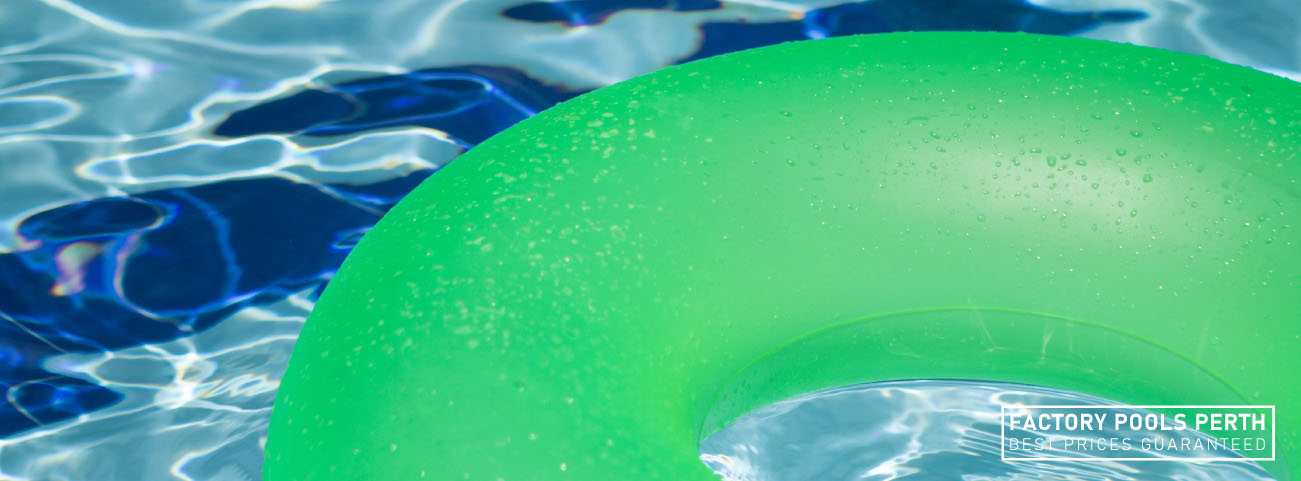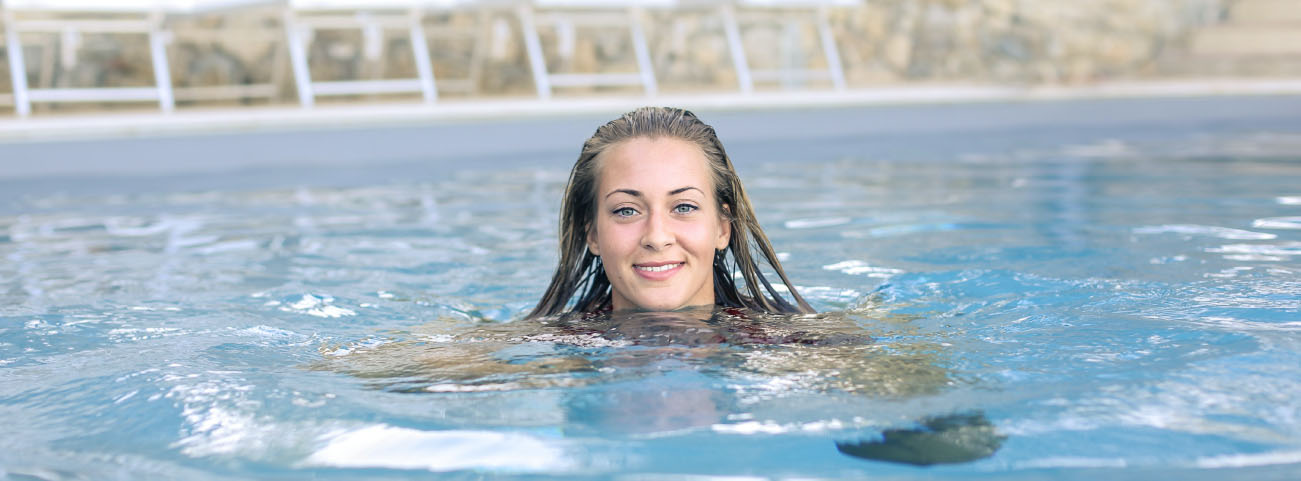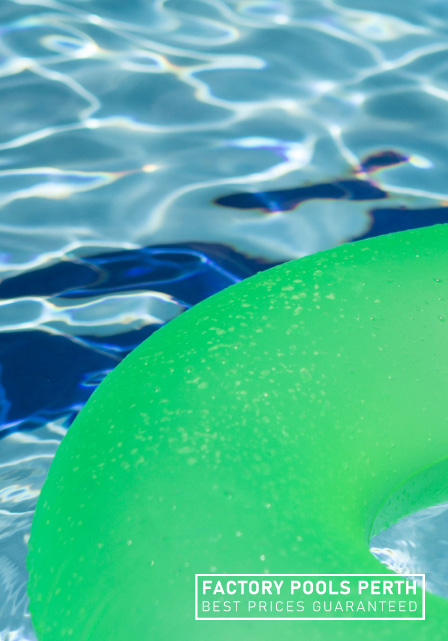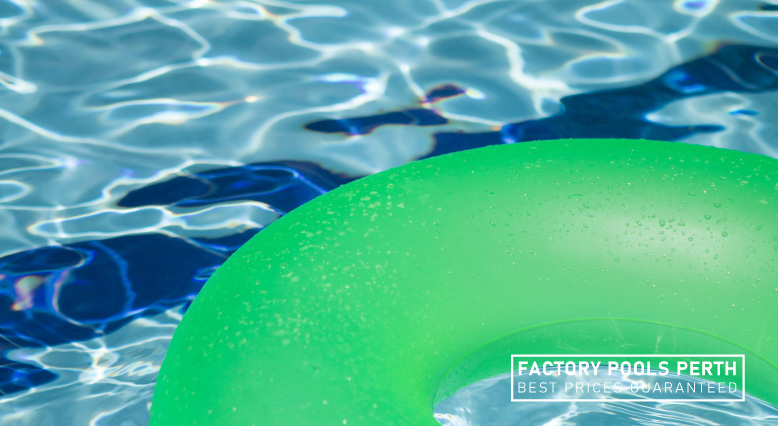Here's How You Can Keep Your Pool Crystal Clear
Having a pool in the backyard is a wonderful way to stay comfortable during the sweltering summer months. It gives you a tranquil oasis to unwind in and gives a safe space to spend a peaceful evening with your family. The swimming pool is also a point of pride for many homeowners. However, managing a pool requires a lot of work, especially if you wish the water to remain crystal clear throughout the year. The water in your pool can quickly get hazy, cloudy, and sometimes even green if you do not take any care of it. It is important to properly clean and maintain your swimming pool to ensure your family can enjoy a comfortable and healthy swimming experience.

Tips for keeping your pool water crystal clear
Cleaning and maintaining your pool to always have sparkling blue and crystal clear water can be achieved easily by following a few simple tricks. Some of them include:
Keep the chemical levels in the pool balanced
The most critical step in maintaining the water in the swimming pool crystal clear is to maintain optimum chemical levels. The levels of pH and chlorine are the main values that you should keep your eyes on. Chlorine plays a crucial function in maintaining the clarity of the pool water. This important chemical eliminates bacteria and other germs from the swimming pool water. How effectively chlorine maintains your pool water depends on the pH level of the pool. The pH level indicates whether your pool water is alkaline or acidic. It is recommended to test your pool water at least two times a week to check the pH and chlorine levels.
The optimal level of pH ranges from 7.2 to 7.6. Similarly, the value of the chlorine level in your swimming pool should fall somewhere between 1.0 and 3.0 ppm. In case your chlorine levels are below the recommended value, you should immediately replenish them. If the pH levels do not fall within the recommended limits, it can cause several issues for the pool. Compounds like sodium bisulphate and muriatic acid should be added to the swimming pool if the pH level of the pool water is high. If the pH of the swimming pool is low, it indicates that the pool has become excessively acidic. To bring up the pH, mix an alkali into the swimming pool water. The most commonly used alkali is sodium carbonate.
Skim frequently
You must frequently remove organic contaminants like insects, leaves, branches, pollen clumps, and other similar debris from the swimming pool to keep the water crystal clear and sparkly. Although your pool filter will catch smaller particles, it is possible that huge contaminants might not enter the filtering system. These contaminants, when left in the pool water for too long, can degrade, leaving the swimming pool cloudy and dirty. Make it a routine to skim your pool frequently to get rid of larger contaminants. How frequently you need to skim the pool depends on the pool’s surroundings. If your pool is surrounded by large trees or leafy bushes, you may have to skim your pool at least twice a day. Once a day is sufficient if your pool is not susceptible to too much foliage.
Along with skimming, it is also important to vacuum and brush the pool regularly. This will help to keep the pool floor and walls clean. You should vacuum and brush the pool at least once a week. This will ensure that your pool is crystal clear.

Backwash
The pool filtering system is essential to maintaining crystal clear water. The filter keeps the pool water clean by filtering out dirt and small debris. But you must routinely clean your filter if you need it to continue functioning properly. Backwashing is a procedure used to clean the pool filter. It involves running water through the filtering system in the reverse direction. This will clean the filtering system. Backwashing is necessary as soon as your pool water becomes cloudy. However, you can prevent cloudiness by keeping track of the reading of the pressure gauge. You should backwash whenever the reading rises between 5 and 7 pounds per square inch.
Administer algaecide and shock your pool
Maintaining proper levels of chlorine and pH may not always be enough to keep the water in your pool clean and dazzling. To get rid of any lingering algae or germs, consider super-chlorinating or shocking your pool at least once every week. You will be able to easily purchase shock treatments from your local pool store. Carefully read the directions given on the package. This will allow you to determine the amount of shock you should add to the water. This amount typically depends on your pool size. If you find algae forming on your pool’s walls, use an algaecide to treat the pool water. It is essential to stop the formation of algae because it can cause the water to turn cloudy, green, or yellow.

Use a good pool cover
Cleaning and maintaining your pool is a difficult task, especially if your pool is surrounded by trees and flowering plants. The leaves and flowers will eventually make their way into your swimming pool despite your best efforts. This unwanted organic debris can negatively affect the pool’s water chemistry and can cause the water to become dirty. Physically removing the debris is a good way to keep the pool clean. But with busy schedules, people may not always have the time to skim their pool for contaminants. This is where a good pool cover can help you. The pool cover will help prevent contaminants from falling into your swimming pool. It also has other benefits, like keeping the pool warm, providing safety to kids and pets, and reducing evaporation.
Conclusion
A swimming pool is a wonderful addition to every backyard. It not only increases the beauty of the property but also increases its value exponentially. But simply installing a swimming pool is not enough. It is crucial to keep the swimming pool sparkling and clean to keep it looking beautiful. This can be easily achieved by regularly taking care of each component of the pool.
Here's How You Can Keep Your Pool Crystal Clear
Having a pool in the backyard is a wonderful way to stay comfortable during the sweltering summer months. It gives you a tranquil oasis to unwind in and gives a safe space to spend a peaceful evening with your family. The swimming pool is also a point of pride for many homeowners. However, managing a pool requires a lot of work, especially if you wish the water to remain crystal clear throughout the year. The water in your pool can quickly get hazy, cloudy, and sometimes even green if you do not take any care of it. It is important to properly clean and maintain your swimming pool to ensure your family can enjoy a comfortable and healthy swimming experience.

Tips for keeping your pool water crystal clear
Cleaning and maintaining your pool to always have sparkling blue and crystal clear water can be achieved easily by following a few simple tricks. Some of them include:
Keep the chemical levels in the pool balanced
The most critical step in maintaining the water in the swimming pool crystal clear is to maintain optimum chemical levels. The levels of pH and chlorine are the main values that you should keep your eyes on. Chlorine plays a crucial function in maintaining the clarity of the pool water. This important chemical eliminates bacteria and other germs from the swimming pool water. How effectively chlorine maintains your pool water depends on the pH level of the pool. The pH level indicates whether your pool water is alkaline or acidic. It is recommended to test your pool water at least two times a week to check the pH and chlorine levels.
The optimal level of pH ranges from 7.2 to 7.6. Similarly, the value of the chlorine level in your swimming pool should fall somewhere between 1.0 and 3.0 ppm. In case your chlorine levels are below the recommended value, you should immediately replenish them. If the pH levels do not fall within the recommended limits, it can cause several issues for the pool. Compounds like sodium bisulphate and muriatic acid should be added to the swimming pool if the pH level of the pool water is high. If the pH of the swimming pool is low, it indicates that the pool has become excessively acidic. To bring up the pH, mix an alkali into the swimming pool water. The most commonly used alkali is sodium carbonate.
Skim frequently
You must frequently remove organic contaminants like insects, leaves, branches, pollen clumps, and other similar debris from the swimming pool to keep the water crystal clear and sparkly. Although your pool filter will catch smaller particles, it is possible that huge contaminants might not enter the filtering system. These contaminants, when left in the pool water for too long, can degrade, leaving the swimming pool cloudy and dirty. Make it a routine to skim your pool frequently to get rid of larger contaminants. How frequently you need to skim the pool depends on the pool’s surroundings. If your pool is surrounded by large trees or leafy bushes, you may have to skim your pool at least twice a day. Once a day is sufficient if your pool is not susceptible to too much foliage.
Along with skimming, it is also important to vacuum and brush the pool regularly. This will help to keep the pool floor and walls clean. You should vacuum and brush the pool at least once a week. This will ensure that your pool is crystal clear.

Backwash
The pool filtering system is essential to maintaining crystal clear water. The filter keeps the pool water clean by filtering out dirt and small debris. But you must routinely clean your filter if you need it to continue functioning properly. Backwashing is a procedure used to clean the pool filter. It involves running water through the filtering system in the reverse direction. This will clean the filtering system. Backwashing is necessary as soon as your pool water becomes cloudy. However, you can prevent cloudiness by keeping track of the reading of the pressure gauge. You should backwash whenever the reading rises between 5 and 7 pounds per square inch.
Administer algaecide and shock your pool
Maintaining proper levels of chlorine and pH may not always be enough to keep the water in your pool clean and dazzling. To get rid of any lingering algae or germs, consider super-chlorinating or shocking your pool at least once every week. You will be able to easily purchase shock treatments from your local pool store. Carefully read the directions given on the package. This will allow you to determine the amount of shock you should add to the water. This amount typically depends on your pool size. If you find algae forming on your pool’s walls, use an algaecide to treat the pool water. It is essential to stop the formation of algae because it can cause the water to turn cloudy, green, or yellow.

Use a good pool cover
Cleaning and maintaining your pool is a difficult task, especially if your pool is surrounded by trees and flowering plants. The leaves and flowers will eventually make their way into your swimming pool despite your best efforts. This unwanted organic debris can negatively affect the pool’s water chemistry and can cause the water to become dirty. Physically removing the debris is a good way to keep the pool clean. But with busy schedules, people may not always have the time to skim their pool for contaminants. This is where a good pool cover can help you. The pool cover will help prevent contaminants from falling into your swimming pool. It also has other benefits, like keeping the pool warm, providing safety to kids and pets, and reducing evaporation.
Conclusion
A swimming pool is a wonderful addition to every backyard. It not only increases the beauty of the property but also increases its value exponentially. But simply installing a swimming pool is not enough. It is crucial to keep the swimming pool sparkling and clean to keep it looking beautiful. This can be easily achieved by regularly taking care of each component of the pool.
Here's How You Can Keep Your Pool Crystal Clear
Having a pool in the backyard is a wonderful way to stay comfortable during the sweltering summer months. It gives you a tranquil oasis to unwind in and gives a safe space to spend a peaceful evening with your family. The swimming pool is also a point of pride for many homeowners. However, managing a pool requires a lot of work, especially if you wish the water to remain crystal clear throughout the year. The water in your pool can quickly get hazy, cloudy, and sometimes even green if you do not take any care of it. It is important to properly clean and maintain your swimming pool to ensure your family can enjoy a comfortable and healthy swimming experience.

Tips for keeping your pool water crystal clear
Cleaning and maintaining your pool to always have sparkling blue and crystal clear water can be achieved easily by following a few simple tricks. Some of them include:
Keep the chemical levels in the pool balanced
The most critical step in maintaining the water in the swimming pool crystal clear is to maintain optimum chemical levels. The levels of pH and chlorine are the main values that you should keep your eyes on. Chlorine plays a crucial function in maintaining the clarity of the pool water. This important chemical eliminates bacteria and other germs from the swimming pool water. How effectively chlorine maintains your pool water depends on the pH level of the pool. The pH level indicates whether your pool water is alkaline or acidic. It is recommended to test your pool water at least two times a week to check the pH and chlorine levels.
The optimal level of pH ranges from 7.2 to 7.6. Similarly, the value of the chlorine level in your swimming pool should fall somewhere between 1.0 and 3.0 ppm. In case your chlorine levels are below the recommended value, you should immediately replenish them. If the pH levels do not fall within the recommended limits, it can cause several issues for the pool. Compounds like sodium bisulphate and muriatic acid should be added to the swimming pool if the pH level of the pool water is high. If the pH of the swimming pool is low, it indicates that the pool has become excessively acidic. To bring up the pH, mix an alkali into the swimming pool water. The most commonly used alkali is sodium carbonate.
Skim frequently
You must frequently remove organic contaminants like insects, leaves, branches, pollen clumps, and other similar debris from the swimming pool to keep the water crystal clear and sparkly. Although your pool filter will catch smaller particles, it is possible that huge contaminants might not enter the filtering system. These contaminants, when left in the pool water for too long, can degrade, leaving the swimming pool cloudy and dirty. Make it a routine to skim your pool frequently to get rid of larger contaminants. How frequently you need to skim the pool depends on the pool’s surroundings. If your pool is surrounded by large trees or leafy bushes, you may have to skim your pool at least twice a day. Once a day is sufficient if your pool is not susceptible to too much foliage.
Along with skimming, it is also important to vacuum and brush the pool regularly. This will help to keep the pool floor and walls clean. You should vacuum and brush the pool at least once a week. This will ensure that your pool is crystal clear.

Backwash
The pool filtering system is essential to maintaining crystal clear water. The filter keeps the pool water clean by filtering out dirt and small debris. But you must routinely clean your filter if you need it to continue functioning properly. Backwashing is a procedure used to clean the pool filter. It involves running water through the filtering system in the reverse direction. This will clean the filtering system. Backwashing is necessary as soon as your pool water becomes cloudy. However, you can prevent cloudiness by keeping track of the reading of the pressure gauge. You should backwash whenever the reading rises between 5 and 7 pounds per square inch.
Administer algaecide and shock your pool
Maintaining proper levels of chlorine and pH may not always be enough to keep the water in your pool clean and dazzling. To get rid of any lingering algae or germs, consider super-chlorinating or shocking your pool at least once every week. You will be able to easily purchase shock treatments from your local pool store. Carefully read the directions given on the package. This will allow you to determine the amount of shock you should add to the water. This amount typically depends on your pool size. If you find algae forming on your pool’s walls, use an algaecide to treat the pool water. It is essential to stop the formation of algae because it can cause the water to turn cloudy, green, or yellow.

Use a good pool cover
Cleaning and maintaining your pool is a difficult task, especially if your pool is surrounded by trees and flowering plants. The leaves and flowers will eventually make their way into your swimming pool despite your best efforts. This unwanted organic debris can negatively affect the pool’s water chemistry and can cause the water to become dirty. Physically removing the debris is a good way to keep the pool clean. But with busy schedules, people may not always have the time to skim their pool for contaminants. This is where a good pool cover can help you. The pool cover will help prevent contaminants from falling into your swimming pool. It also has other benefits, like keeping the pool warm, providing safety to kids and pets, and reducing evaporation.
Conclusion
A swimming pool is a wonderful addition to every backyard. It not only increases the beauty of the property but also increases its value exponentially. But simply installing a swimming pool is not enough. It is crucial to keep the swimming pool sparkling and clean to keep it looking beautiful. This can be easily achieved by regularly taking care of each component of the pool.

